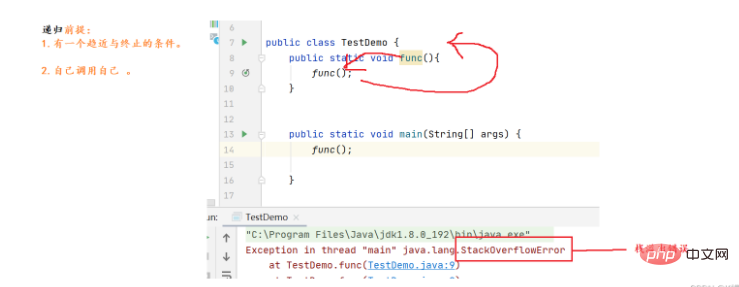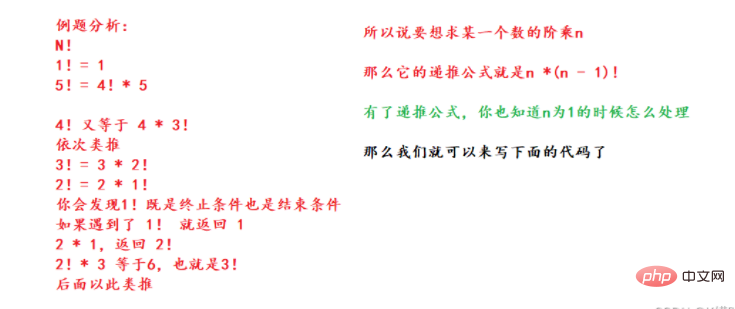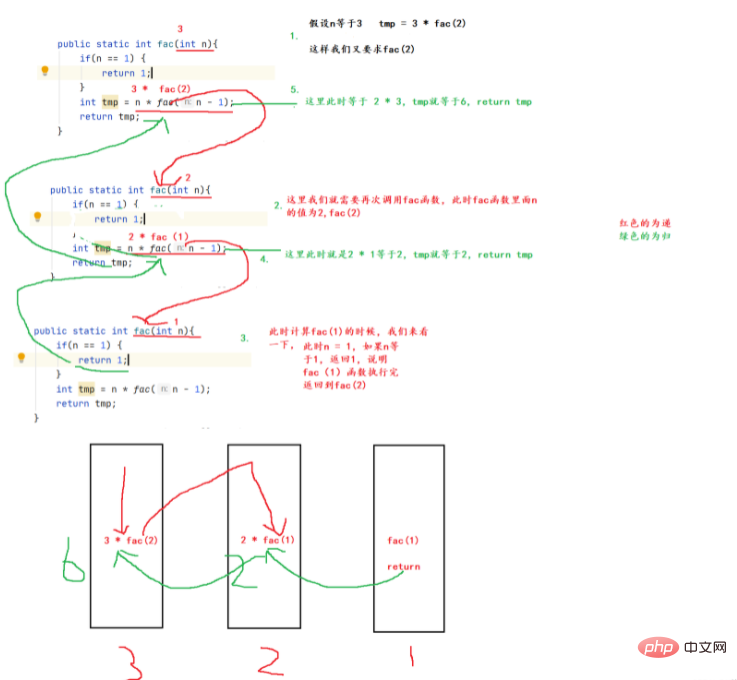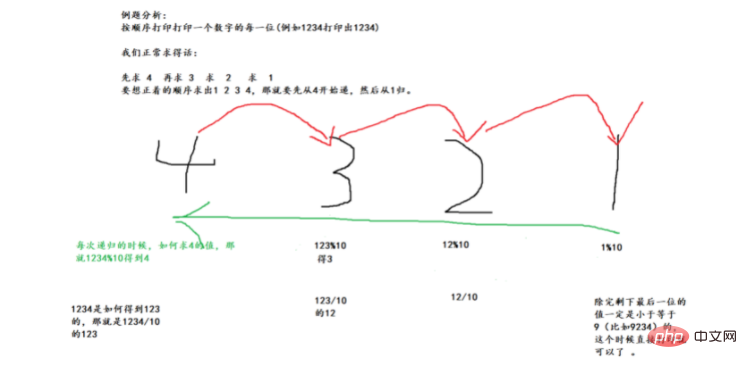Java Recursion: Concepts and Usage
1. The concept of recursion
1. What is recursion?
Recursion is: the process of calling a method by itself.
There are two prerequisites for using recursion:
1. There is an approach and termination condition.
2. Call yourself.
How to implement recursion?
The most important way is: to implement recursion, you need to derive a recursive formula.
The way to think about recursion: think laterally and think according to the recursive formula.
Code execution: vertical execution.
2. Recursion explanation
First look at the following code:
public class TestDemo {
public static void func(){
func(); //自己调用自己本身
}
public static void main(String[] args) {
func();
}
}The code above is a simple recursion.
Let’s take a look at the running results of this code.
Drawing explanation:

For the recursion in the above picture, there is no A condition that tends to terminate, so this function will recurse endlessly. Every time you recurse, memory must be allocated on the stack. If you keep allocating memory on the stack, the stack will eventually overflow.
Veterans, please remember: Once there is a problem with the recursion you write, if the boundary is not found correctly, a

will be reported. If it is reported, This error must be because your termination condition is wrong, or the termination condition is not written, which causes your recursion to be too deep, and eventually the stack overflows.
If we want the above code to be correct, we need to add a termination condition to it.
The correct code is as follows:
public class TestDemo {
public static void func(int n){
if(n == 1) return;
func(n -1);
}
public static void main(String[] args) {
func(3);
}
}The following will give you a deeper understanding of recursion through simple examples
2. The use of recursion
Example: Recursion Method to find the factorial of n Drawing analysis:

Implementation code:
public class TestDemo {
public static int fac(int n){
if(n == 1) {
return 1;
}
int tmp = n * fac(n - 1);
return tmp;
}
public static void main(String[] args) {
System.out.println(fac(5));
}
}Code drawing explanation:

Example question: Find the sum of n
Drawing analysis:

Implementation code:
第一种写法:
public class TestDemo {
public static int sumAdd(int n){
if(n == 1) {
return 1;
}
int tmp = n + sumAdd(n - 1);
return tmp;
}
public static void main(String[] args) {
System.out.println(sumAdd(3));
}
}
第二种写法:
public class TestDemo {
public static int sumAdd(int n){
if(n == 1) {
return 1;
}
return n + sumAdd(n -1);
}
public static void main(String[] args) {
System.out.println(sumAdd(3));
}
}Example question: Recursive implementation prints each item in order One-digit number
Drawing analysis:

Implementation code:
public class TestDemo {
public static void print(int n){
if(n < 10){
System.out.print(n+" ");
}else{
print(n/10);
System.out.print(n%10+" ");
}
}
public static void main(String[] args) {
print(1234);
}
}Example: Write a recursive method and input a non-negative integer , returns the sum of the numbers that make up it. For example: if you enter 1729, it should return 1 7 2 9
Implementation code:
public class TestDemo {
public static int sumEveryone(int n){
if(n < 10){
return n;
}else{
return n%10 + sumEveryone(n/10);
}
}
public static void main(String[] args) {
System.out.println(sumEveryone(7910));
}
}Example question: Find the nth Fibonacci number
Drawing analysis:

Implementation code:
第一种方法:递归
public class TestDemo {
public static int fib(int n){
if(n == 1 || n == 2){
return 1;
}else{
return fib(n-2)+fib(n-1);
}
}
public static void main(String[] args) {
System.out.println(fib(5));
}
第二种方法:叫做循环(迭代)实现
public static int fib2(int n){
if(n == 1 || n==2){
return 1;
}
int f1 = 1;
int f2 = 1;
int f3 = 0;
for (int i = 3; i < n; i++) {
f3 = f1+f2;
f1 = f2;
f2 = f3;
}
return f3;
}
public static void main(String[] args) {
System.out.println(fib2(45));
}The above is the detailed content of Java Recursion: Concepts and Usage. For more information, please follow other related articles on the PHP Chinese website!

Hot AI Tools

Undresser.AI Undress
AI-powered app for creating realistic nude photos

AI Clothes Remover
Online AI tool for removing clothes from photos.

Undress AI Tool
Undress images for free

Clothoff.io
AI clothes remover

Video Face Swap
Swap faces in any video effortlessly with our completely free AI face swap tool!

Hot Article

Hot Tools

Notepad++7.3.1
Easy-to-use and free code editor

SublimeText3 Chinese version
Chinese version, very easy to use

Zend Studio 13.0.1
Powerful PHP integrated development environment

Dreamweaver CS6
Visual web development tools

SublimeText3 Mac version
God-level code editing software (SublimeText3)

Hot Topics
 1669
1669
 14
14
 1428
1428
 52
52
 1329
1329
 25
25
 1273
1273
 29
29
 1256
1256
 24
24
 PHP: A Key Language for Web Development
Apr 13, 2025 am 12:08 AM
PHP: A Key Language for Web Development
Apr 13, 2025 am 12:08 AM
PHP is a scripting language widely used on the server side, especially suitable for web development. 1.PHP can embed HTML, process HTTP requests and responses, and supports a variety of databases. 2.PHP is used to generate dynamic web content, process form data, access databases, etc., with strong community support and open source resources. 3. PHP is an interpreted language, and the execution process includes lexical analysis, grammatical analysis, compilation and execution. 4.PHP can be combined with MySQL for advanced applications such as user registration systems. 5. When debugging PHP, you can use functions such as error_reporting() and var_dump(). 6. Optimize PHP code to use caching mechanisms, optimize database queries and use built-in functions. 7
 PHP vs. Python: Understanding the Differences
Apr 11, 2025 am 12:15 AM
PHP vs. Python: Understanding the Differences
Apr 11, 2025 am 12:15 AM
PHP and Python each have their own advantages, and the choice should be based on project requirements. 1.PHP is suitable for web development, with simple syntax and high execution efficiency. 2. Python is suitable for data science and machine learning, with concise syntax and rich libraries.
 Break or return from Java 8 stream forEach?
Feb 07, 2025 pm 12:09 PM
Break or return from Java 8 stream forEach?
Feb 07, 2025 pm 12:09 PM
Java 8 introduces the Stream API, providing a powerful and expressive way to process data collections. However, a common question when using Stream is: How to break or return from a forEach operation? Traditional loops allow for early interruption or return, but Stream's forEach method does not directly support this method. This article will explain the reasons and explore alternative methods for implementing premature termination in Stream processing systems. Further reading: Java Stream API improvements Understand Stream forEach The forEach method is a terminal operation that performs one operation on each element in the Stream. Its design intention is
 PHP vs. Other Languages: A Comparison
Apr 13, 2025 am 12:19 AM
PHP vs. Other Languages: A Comparison
Apr 13, 2025 am 12:19 AM
PHP is suitable for web development, especially in rapid development and processing dynamic content, but is not good at data science and enterprise-level applications. Compared with Python, PHP has more advantages in web development, but is not as good as Python in the field of data science; compared with Java, PHP performs worse in enterprise-level applications, but is more flexible in web development; compared with JavaScript, PHP is more concise in back-end development, but is not as good as JavaScript in front-end development.
 PHP vs. Python: Core Features and Functionality
Apr 13, 2025 am 12:16 AM
PHP vs. Python: Core Features and Functionality
Apr 13, 2025 am 12:16 AM
PHP and Python each have their own advantages and are suitable for different scenarios. 1.PHP is suitable for web development and provides built-in web servers and rich function libraries. 2. Python is suitable for data science and machine learning, with concise syntax and a powerful standard library. When choosing, it should be decided based on project requirements.
 PHP's Impact: Web Development and Beyond
Apr 18, 2025 am 12:10 AM
PHP's Impact: Web Development and Beyond
Apr 18, 2025 am 12:10 AM
PHPhassignificantlyimpactedwebdevelopmentandextendsbeyondit.1)ItpowersmajorplatformslikeWordPressandexcelsindatabaseinteractions.2)PHP'sadaptabilityallowsittoscaleforlargeapplicationsusingframeworkslikeLaravel.3)Beyondweb,PHPisusedincommand-linescrip
 PHP: The Foundation of Many Websites
Apr 13, 2025 am 12:07 AM
PHP: The Foundation of Many Websites
Apr 13, 2025 am 12:07 AM
The reasons why PHP is the preferred technology stack for many websites include its ease of use, strong community support, and widespread use. 1) Easy to learn and use, suitable for beginners. 2) Have a huge developer community and rich resources. 3) Widely used in WordPress, Drupal and other platforms. 4) Integrate tightly with web servers to simplify development deployment.
 PHP vs. Python: Use Cases and Applications
Apr 17, 2025 am 12:23 AM
PHP vs. Python: Use Cases and Applications
Apr 17, 2025 am 12:23 AM
PHP is suitable for web development and content management systems, and Python is suitable for data science, machine learning and automation scripts. 1.PHP performs well in building fast and scalable websites and applications and is commonly used in CMS such as WordPress. 2. Python has performed outstandingly in the fields of data science and machine learning, with rich libraries such as NumPy and TensorFlow.




